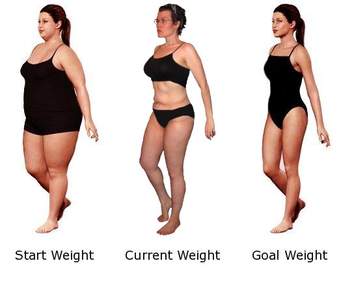THE FOUNDATION OF WEIGHT LOSS
The Importance of Weight Loss and Exercise
Carrying around too much weight feels uncomfortable, and it can also damage your health. According the Centers of Disease Control and Prevention
(CDC), obesity rates have skyrocketed in the United States in recent
years. As of 2010, more than one-third of American adults were
considered obese, defined as having a body mass index (BMI) of 30 or
higher. Body mass is derived by dividing weight in pounds by height in
inches squared, and then multiplying the result by 703 (weight (lb) /
[height (in)] 2 x 703). You can calculate your body mass by following these three steps:
- Multiply your weight in pounds by 703.
- Calculate your height in inches squared.
- Divide the resulting number from step 1 by the resulting number in step 3.
Obesity can lead to a number of serious health problems, including heart disease, diabetes, stroke, and some types of cancer.
One method that can help a person lose weight is to
limit the number of calories taken in through their diet. The other way
is to burn extra calories with exercise.
Benefits of Exercise vs. Diet
Combining exercise with a healthy diet is a more
effective way to lose weight than depending on calorie restriction
alone. Exercise can prevent or even reverse the effects of certain
diseases. Exercise lowers blood pressure and cholesterol, which may
prevent a heart attack.
In addition, if you exercise, you lower your risk of
developing certain types of cancers such as colon and breast cancer.
Exercise is also known to help contribute to a sense of confidence and
well-being, thus possibly lowering rates of anxiety and depression.
Exercise is helpful for weight loss and maintaining weight loss.
Exercise can increase metabolism, or how many calories you burn in a
day. It can also help you maintain and increase lean body mass, which
also helps increase number of calories you burn each day.
How Much Exercise Is Needed for Weight Loss?
To reap the health benefits of exercise, it is
recommended that you to perform some form of aerobic exercise at least
three times a week for a minimum of 20 minutes per session. However,
more than 20 minutes is better if you want to actually lose weight.
Incorporating just 15 minutes of moderate exercise — such as walking one
mile — on a daily basis will burn up to 100 extra calories (assuming
you don’t consume excess calories in your diet afterwards). Burning 700
calories a week can equals 10 lbs. of weight loss over the course of a
year.
Calculating Your Target Heart Rate
To receive all of the health benefits of exercise,
you’ll need to mix in some higher intensity exercises. To get an idea
of how hard you are working, you can check your heart rate. The basic
formula for determining your target heart rate is to subtract your age
from 220 and then calculate 60 to 80 percent of that number.
Talk to a trainer or your healthcare team to help you
determine your best intensity for each workout. Those with special
health concerns such as an injury, diabetes, or a heart condition should
consult a physician before beginning any fitness program.
What Are Some Examples of the Different Types of Exercise?
The type of exercise you choose for weight loss
doesn’t matter as much as whether or not you’re doing it. That’s why
experts recommend you pick exercises you enjoy, so that you’ll stick to a
regular routine.
Aerobic
No matter what exercise program you implement, it
should include some form of aerobic or cardiovascular exercise. Aerobic
exercises get your heart rate up and your blood pumping. Aerobic
exercises may include walking, jogging, cycling, swimming, and dancing.
You can also work out on a fitness machine such as a treadmill,
elliptical, or stair stepper.
Weight Training
A big advantage of working out with weights is that,
in addition to shedding fat, you’ll build muscle. Muscle, in turn, burns
calories. Talk about a healthy feedback loop! Experts recommend working
all the major muscle groups three times per week. This includes:
- abs
- back
- biceps
- calves
- chest
- forearms
- hamstrings
- quads
- shoulders
- traps
- triceps
Yoga
Yoga is not as intense as other types of exercise, but it can help you lose weight in other ways, according to a recent study by researchers at the Fred Hutchinson Cancer Research Center. The study found that people who practice yoga are more mindful about what they eat and, therefore, less likely to be obese.
Incorporating Exercise Into Your Lifestyle
The total amount of exercise you engage in during a
day matters more than whether or not you do it in a single session.
That’s why small changes in your daily routine can make a big difference
in your waistline.
Healthy lifestyle habits to consider include:
- walking or riding your bike to work or while running errands
- taking the stairs instead of the elevator
- parking farther away from destinations and walking the remaining distance
Activities and the Amount of Calories They Burn
The average adult male who doesn’t exercise requires
approximately 2,200 calories a day to maintain his average weight. A
female needs about 1,800 calories to maintain her weight.
The following list contains common activities and the approximate amount of calories burned per hour:
Activities
|
Calories Burned
|
playing baseball, golf, or cleaning the house
|
240 to 300
|
brisk walking, biking, dancing, or gardening
|
370 to 460
|
playing football, jogging (at a nine-minute-mile pace), or swimming
|
580 to 730
|
skiing, racquetball, or running (at a seven-minute-mile pace)
|
740 to 920
|
Before You Start an Exercise Program
Talk to your doctor before you start a new exercise
program, especially if you are planning on doing vigorous exercise.
This is especially important if you have:
- heart disease
- lung disease
- diabetes
- kidney disease
- arthritis
People who have been very inactive for the recent
months, who are overweight, or have recently quit smoking should also
talk to their doctors before staring a new exercise program.
When you are first starting a new exercise program, it’s important to pay attention to the signals your body is giving you. You should push yourself, so that your fitness level
improves. However, pushing yourself too hard can cause you to injure
yourself. Stop exercising if you start to experience pain or shortness
of breath.


.jpeg)



.jpeg)
.jpeg)
.jpeg)
.jpeg)
.jpeg)